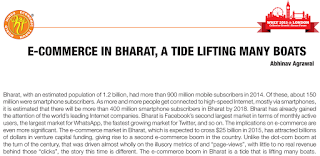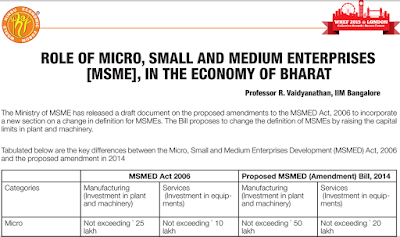 India, with an estimated population of 1.2 billion, had more than 900 million mobile subscribers in 2014. Of these, about 150 million were smartphone subscribers. As more and more people get connected to high-speed Internet, mostly via smartphones, it is estimated that there will be more than 400 million smartphone subscribers in India by 2018. India has already gained the attention of the world's leading Internet companies. India is Facebook's second largest market in terms of monthly active users, the largest market for WhatsApp, the fastest growing market for Twitter, and so on. The implications on e-commerce are even more significant. The e-commerce market in India, which is expected to cross $25 billion in 2015, has attracted billions of dollars in venture capital funding, giving rise to a second e-commerce boom in the country. Unlike the dot-com boom at the turn of the century, that was driven almost wholly on the illusory metrics of and "page-views", with little to no real revenue behind those "clicks", the story this time is different. The e-commerce boom in India is a tide that is lifting many boats.
India, with an estimated population of 1.2 billion, had more than 900 million mobile subscribers in 2014. Of these, about 150 million were smartphone subscribers. As more and more people get connected to high-speed Internet, mostly via smartphones, it is estimated that there will be more than 400 million smartphone subscribers in India by 2018. India has already gained the attention of the world's leading Internet companies. India is Facebook's second largest market in terms of monthly active users, the largest market for WhatsApp, the fastest growing market for Twitter, and so on. The implications on e-commerce are even more significant. The e-commerce market in India, which is expected to cross $25 billion in 2015, has attracted billions of dollars in venture capital funding, giving rise to a second e-commerce boom in the country. Unlike the dot-com boom at the turn of the century, that was driven almost wholly on the illusory metrics of and "page-views", with little to no real revenue behind those "clicks", the story this time is different. The e-commerce boom in India is a tide that is lifting many boats. Bright, young minds have returned to India in the recent past, bringing technology expertise gained from working for the best and biggest technology companies in the world. These people bring with them years of having worked and created successful products and solutions for their multi-national employers. Lured partly by sky-high salaries that e-commerce companies are offering to lure these smart people back to their motherland, partly by the promise of creating the next big and world-class company out of India, serving the Indian consumer, these technologists are bringing back not only their skills, but also their experience of what it takes to build globally successful companies. These people will end up mentoring several other youngsters, both within and outside. The benefits are multi-faceted. The "brain-drain" that had afflicted India for decades may finally be seeing an end - a slow end perhaps, but the light seems to be visible at the end of the tunnel.
Bright, young minds have returned to India in the recent past, bringing technology expertise gained from working for the best and biggest technology companies in the world. These people bring with them years of having worked and created successful products and solutions for their multi-national employers. Lured partly by sky-high salaries that e-commerce companies are offering to lure these smart people back to their motherland, partly by the promise of creating the next big and world-class company out of India, serving the Indian consumer, these technologists are bringing back not only their skills, but also their experience of what it takes to build globally successful companies. These people will end up mentoring several other youngsters, both within and outside. The benefits are multi-faceted. The "brain-drain" that had afflicted India for decades may finally be seeing an end - a slow end perhaps, but the light seems to be visible at the end of the tunnel.
Second, the explosive growth in e-commerce in India has spurred the creation of ancillary segments that did not exist till a few years ago. Terms like "hyper-local" are used to describe these business models. E-commerce companies have been hiring delivery personnel - who complete the final, "last mile" of the delivery chain, pushing up salaries from basic, minimum levels. For example, Delhivery, an "express logistics services" company based out of Delhi NCR, has increased its delivery fleet strength to over 10,000 (article in Economic Times, May 19, 2015). These delivery persons can earn up to Rs 15,000 a month, and sometimes even more. Just as the BPO wave in India a decade ago led to the explosive mushrooming of tax services in cities like Bengaluru, so has the e-commerce boom created a market for young people who otherwise may have been completely shut off from the employment market. A new class of young, urban, youth is entering the workforce.
The success of e-commerce is premised in no small measure on the quality of the logistics and supply-chain of the company. It is one thing to get a million page-views on a web site, and quite another to fulfill ten thousand, fifty thousand, or even a hundred thousand orders a day. Along with Internet speeds, customer expectations have also accelerated. Customer are no longer willing to accept week-long delays in their online order to be delivered. They now expect orders to be fulfilled and delivered in a couple of days - sometimes even within hours! Meeting these expectations requires that e-commerce companies invest in cutting-edge supply-chain and logistics software solutions that not only determine the precise sequence in which orders should be routed within a warehouse - from picking to packing and loading - but also predict demand of items with great accuracy. This helps cut down on idle inventory, saves on warehouse storage and pilferage costs, and helps avoid the dreaded "out-of-stock" messages for customers. Equally importantly, physical infrastructure is being created in the process. Massive warehouses are sprouting up in India - some larger than a quarter million square feet - to meet this demand. Most are located on the outskirts of large towns like Mumbai, Bengaluru, Hyderabad, Delhi. Construction companies are raising the bar on their competencies, offering designs and construction of warehouses that match international standards. Transportation companies are scrambling to upgrade their fleets, equipping their drivers with handheld devices, and the trucks with smart sensors and GPS receivers. Entire industries in India are undergoing a generational technological change as a result.
The e-commerce boom is therefore driving a quantum leap not witnessed before in India's domestic logistics industry, estimated at a little under $200 billion. Of this, third-party and fourth-party logistics companies are creating a modern, viable backbone for the shipping and tracking of goods across the length and breadth of the nation, and getting funded. Start-ups in this space have been funded to the tune of more than $300 million in 2015, according to data from VCCEdge.
All this is happening today, on the ground, even without taking into account the effect that the Indian government's Smart Cities Mission will have. These smart cities will have a pervasive technological underpinning as one of their foundational pillars, from e-governance and e-enabling citizen services, to smart transportation, to homes equipped with smart meters, to pervasive broadband connectivity. All this will further lower the barriers to pervasive e-commerce.
It is important, however, to temper this euphoria with a healthy dose of a reality-check. It is a matter of some satisfaction that in the list of the world's largest startups based on market valuations, India features Flipkart, SnapDeal, Ola Cabs, InMobi, and Zomato. Not one of them however has crossed a billion dollars in annual revenue, yet. In the list of the world's largest e-commerce companies in 2015, China has three - JingDong Mall, Tencent, and Alibaba - in the top 10. India has none. While JingDong had annual revenues of $17 billion, Flipkart - India's largest - had not yet crossed $1 billion. There are undeniable signs of a bubble in the Indian e-commerce market. The deflation of the bubble will cause undeniable pain, and much pessimism from many quarters.
This time around, however, the e-commerce sector in India is driving more than just the e-tail sector growth. It is proving to be the catalyst for entire sectors in the Indian economy, and becoming a symbiotic part of the economy as a whole. From the beginning of recorded time to sometime in the eighteenth century, the Indian economy was the largest in the world and a driver of world economic growth. The Indian entrepreneur, always enterprising, rarely appreciated in a slowly-fading era of socialist mindsets, is now unshackled and riding the e-commerce wave to help drive a reversion to the historical mean.
Sources: "Internet Trends, 2015", KPCB, Wikipedia, etc...
 This article first appeared in the conference journal of the World Hindu Economic Forum's 2015 conference in London. The article as published was lightly edited.
This article first appeared in the conference journal of the World Hindu Economic Forum's 2015 conference in London. The article as published was lightly edited.The journal also had very informative articles by eminent personalities such as Dr. Bibek Debroy and Prof. R Vaidyanathan, among others.
© 2015, Abhinav Agarwal (अभिनव अग्रवाल). All rights reserved.


